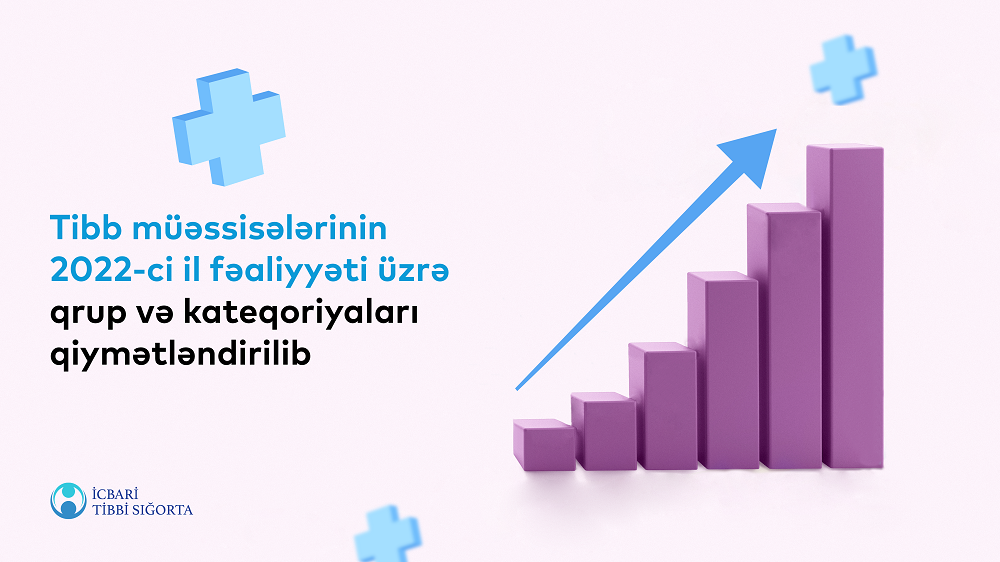18 May 2023 10:06
İcbari Tibbi Sığorta üzrə Dövlət Agentliyi tibb müəssisələrinin qiymətləndirilməsinin nəticələrini açıqlayıb
İcbari Tibbi Sığorta üzrə Dövlət Agentliyinin yaratdığı xüsusi komitə tərəfindən “Tibbi Ərazi Bölmələrini İdarəetmə Birliyi” (TƏBİB) publik hüquqi şəxsin tabeliyindəki tibb müəssisələrinin 2022-ci il fəaliyyəti üzrə qrup və kateqoriyaları yenidən qiymətləndirilib.
Qiymətləndirmə tibb müəssisələrində qabaqcıl iş üsullarının tətbiqi, kadr potensialının gücləndirilməsi, tibbi xidmətin keyfiyyətinin yüksəldilməsi, tibb müəssisələrində çalışan heyətin layiqli həyat səviyyəsinə uyğun əməkhaqqı ilə təmin edilməsi məqsədlərini daşıyır və tibb müəssisələri arasında sağlam rəqabət mühitinin inkişaf etdirilməsinə xidmət edir.
Tibb müəssisələrinin dəyərləndirilməsi günlük orta müraciətlərin, illik stasionar cərrahi əməliyyatların sayı, tibbi avadanlıqların mövcudluğu kimi kəmiyyət meyarları və xəstələrin çarpayıda keçirdiyi orta günlərin, həkim ixtisaslarının, xaricdə təhsil almış həkim mütəxəssislərin sayı, laboratoriyalarda aparılan analizlərin çeşidlilik səviyyəsi kimi keyfiyyət meyarları üzrə həyata keçirilir.
Qiymətləndirmənin nəticələrinə gəldikdə isə qeyd olunmalıdır ki, vətəndaşlara göstərilən tibbi xidmətlərin əlçatanlığı və keyfiyyətinin yüksəldilməsi baxımından 2021-ci il ilə müqayisədə 2022-ci ildə tibb müəssisələrinin fəaliyyətində mühüm irəliləyişlər qeydə alınıb və onlar qrup və kateqoriya göstəriciləri üzrə yüksəlibər.
Belə ki, Abşeron Rayon Mərkəzi Xəstəxanasının qrup və kateqoriyası 2B-dən 3B-yə yüksəlib. Müəssisənin geniş spektrli xidmət çeşidinə malik olması, xidmət göstərdiyi ərazinin genişliyi və sakinlərinin sayının çoxluğu nəzərə alınaraq o, ümumi profilli tibb müəssisəsi statusundan çoxprofilli tibb müəssisəsi statusuna keçid almışdır. Saray Modul tipli Xəstəxananın birləşdirilməsi hesabına Abşeron Rayon Mərkəzi Xəstəxanasında çarpayıların sayı 180-dən 372-yə yüksəlmiş, 2021-ci il ilə müqayisədə pasiyentlərə göstərilən ambulator və stasionar xidmətlərin, habelə aparılmış cərrahi əməliyyatların sayı artmışdır. Quraşdırılmış əlavə avadanlıqlar hesabına isə tibb müəssisəsinin laboratoriya səviyyəsi 3-cü səviyyədən 4-cü səviyyəyə yüksəlmişdir ki, bu da öz növbəsində vətəndaşların daha geniş laborator xidmətlərdən istifadə etməsinə imkan verir.
Şəmkir Rayon Mərkəzi Xəstəxanası və Quba Rayon Mərkəzi Xəstəxanasının kateqoriyaları isə 2B-dən 2A-ya yüksəlmişdir. Şəmkir Rayon Mərkəzi Xəstəxanasında əlavə avadanlıqların quraşdırılması, cərrahi əməliyyatların sayının artması, habelə "Xəstələrin çarpayıda keçirdiyi orta günlərin sayı” və "İcbari tibbi sığorta çərçivəsində göstərilən tibbi xidmətlərin reyestr məlumatlarında xəta payı" kimi keyfiyyət göstəricilərinin yaxşılaşması müəssisənin kateqoriyasının artmasına səbəb olmuşdur. Quba Rayon Mərkəzi Xəstəxanasının kateqoriyasında baş vermiş yüksəliş isə COVID-19-la mübarizə aparan tibb müəssisəsi statusunun ləğv olunması nəticəsində günlük müraciətlərin orta göstəricisinin, həkim personalının sayının artması, "Xəstələrin çarpayıda keçirdiyi orta günlərin sayı" və "İcbari tibbi sığorta çərçivəsində göstərilən tibbi xidmətlərin reyestr məlumatlarında xəta payı" keyfiyyət göstəriciləri yaxşılaşması ilə əlaqəlidir.
Qaradağ və Pirallahı Tibb Mərkəzləri və Qobustan Rayon Mərkəzi Xəstəxanasında "Xəstələrin çarpayıda keçirdiyi orta günlərin sayı" və "İcbari tibbi sığorta çərçivəsində göstərilən tibbi xidmətlərin reyestr məlumatlarında xəta payı" keyfiyyət göstəricilərinin yaxşılaşması, həmçinin Qobustan Rayon Mərkəzi Xəstəxanasında bu göstəricilərlə yanaşı həkim sayının artması hesabına sözügedən tibb müəssisələrinin kateqoriyalarının 2D-dən 2C-yə yüksəlməsi ilə nəticələnmişdir.
Məlumat üçün bildirək ki, qiymətləndirmənin yekunlarına əsasən müəyyənləşən qrup və kateqoriyaları üzrə tibb müəssisələrinin heyəti həvəsləndirici əlavələr ilə təmin olunurlar. Belə ki, tibb müəssisəsinin fəaliyyət göstəriciləri həvəsləndirici əlavələr ilə düz mütənasiblik təşkil edir. Başqa sözlə desək, tibb və qeyri-tibb personalının aldığı həvəsləndirici əlavələrin məbləği tibb müəssisələrinin fəaliyyət göstəricilərindən asılı olaraq dəyişir. Sözügedən proses “Tibbi Ərazi Bölmələrini İdarəetmə Birliyi” publik hüquqi şəxsin tabeliyindəki tibb müəssisələrində çalışan səhiyyə işçilərinin əməyinin ödənilməsi Qaydası” ilə tənzimlənir.
Sözügedən Qaydaya əsasən tibb müəssisələrində çalışan işçilərinin əməkhaqlarının formalaşdırılmasında ədalətlilik prinsipinin təmin olunması məqsədilə tibb müəssisələri 3 qrupa və hər qrup üzrə müvafiq olaraq A, B, C, D kateqoriyalarına bölünürlər. I qrup – ilkin səhiyyə xidməti göstərən tibb müəssisələri, II qrup – ümumi profilli tibb müəssisələri, III qrup – çoxprofilli və elmi-tədqiqat tibb müəssisələrini əhatə edir.
Ambulator fəaliyyət üzrə həkim-pediatrın 9-cu dərəcə aylıq vəzifə (tarif) maaşı 478 AZN, aylıq sabit həvəsləndirici əlavəsi 800 AZN və işin nəticələrinə görə aylıq həvəsləndirici əlavəsi 300 AZN (rəqəm şərtidir, məbləğ aylıq pasiyent qəbuluna görə dəyişir) təşkil edir. 2B kateqoriyalı xəstəxanada həkimin işin nəticəsinə görə həvəsləndirici əlavəsi 1.2 əmsalı ilə hesablanırdısa, dəyişiklikdən sonra, yəni 3B kateqoriyalı xəstəxanada 1.4 əmsalı ilə hesablanır. Beləliklə, 2B kateqoriyası üzrə həkimin aylıq ümumi əməkhaqqısı 1638 AZN (478+800+300*1.2), 3B kateqoriyası üzrə isə 1698 AZN (478+800+300*1.4) təşkil edəcək. Qeyd edək ki, məvaciblər vergilər və digər məcburi ödənişlər daxil olmaqla göstərilmişdir.
Xəbərlər
İcbari tibbi sığorta ilə 182 000-dən artıq doğuş aparılıb
16 İyul 2024 11:10
Diz oynağının endoprotezləşməsində İsveçrə istehsalı protezlərdən istifadə olunur
12 İyul 2024 10:42
Kəskin orta otitin cərrahi müalicəsi icbari tibbi sığorta ilə qarşılanır
09 İyul 2024 11:11
Tiroidektomiya əməliyyatı icbari tibbi sığorta ilə ödənişsizdir
05 İyul 2024 10:25
İcbari tibbi sığorta ilə qasıq yırtığı açıq və laparoskopik üsulla bərpa olunur
01 İyul 2024 15:18
İcbari Tibbi Sığorta üzrə Dövlət Agentliyinin nümayəndə heyəti Yaponiyaya işgüzar səfər edib
28 İyun 2024 10:51
İcbari tibbi sığorta ilə 540 splenektomiya əməliyyatı icra olunub
24 İyun 2024 14:52
Zaur Əliyev Goranboy şəhərində vətəndaşları qəbul edib
21 İyun 2024 17:00
İcbari tibbi sığorta uşaqlığın çıxarılması əməliyyatını qarşılayır
21 İyun 2024 10:57
Agentlik, TƏBİB və Ankara Universiteti üçtərəfli anlaşma memorandumu imzaladı
14 İyun 2024 14:49










